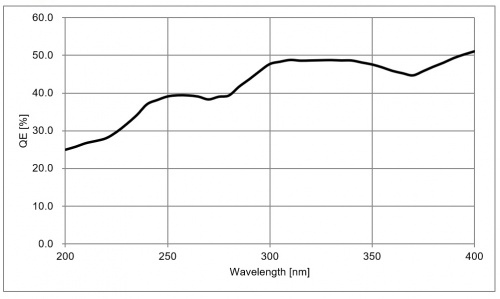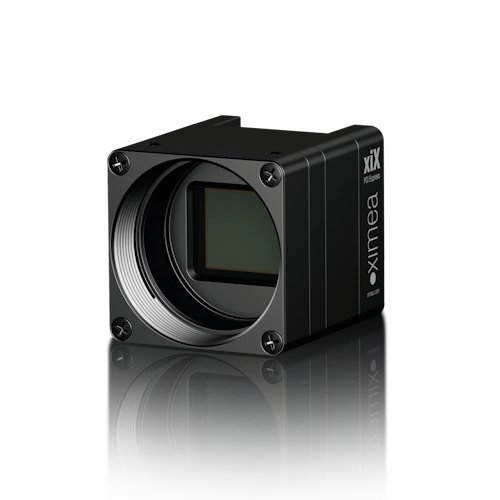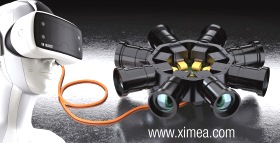Wednesday, 10 April 2024 00:00
Last Updated on Tuesday, 16 April 2024 10:40
Written by Administrator

XIMEA explores quantum efficiency in the UV wavelength range with its latest scientific camera
Muenster, Germany, April 2024 – As part of its xiLAB initiative, XIMEA expands the offer of Ultraviolet cameras with MX081 models.
Within the realm of modern technology, cameras have progressed from mere devices capturing visible light to sophisticated tools divulging concealed facets of the electromagnetic spectrum.
One of the innovations is the UV camera, delving beyond human visual perception, and unlocking a realm of information that was previously unattainable.
UV cameras operate on the principle of capturing ultraviolet (UV) light, an unseen segment of the electromagnetic spectrum bearing insights into various phenomena, from forensics to astronomy.
UV cameras function by capturing the UV light that objects reflect or emit.
They employ specialized sensors or filters detecting and recording UV wavelengths.
Unlike traditional cameras relying on visible light, UV cameras integrate components designed to prevent contamination from visible and infrared light sources, ensuring that captured images are primarily influenced by UV radiation.
The MX081 model features Sony's IMX487 sensor, renowned for its superior image quality, low noise, and high sensitivity.
The camera delivers exceptional performance and reliability, leveraging Sony's advanced sensor technology, ensuring consistent results in demanding environments.
With a spectral range extending from 200 to 400 nm, XIMEA's MX081 model of UV camera captures UV radiation with exceptional sensitivity and accuracy.
This specific wavelength range allows for the detection of subtle variations in UV reflectance and fluorescence, enabling enhanced analysis and visualization of target materials and substances.
Equipped with a resolution of 8.1 megapixels (2856 x 2848 pixels), the camera delivers sharp, detailed images with precise pixel-level clarity.
With a frame rate of 59 frames per second (FPS), the MX081 camera enables smooth, real-time imaging of dynamic scenes and fast-moving objects.
This high frame rate is ideal for applications requiring rapid image capture, such as machine vision, motion analysis, and quality control in manufacturing processes.
Measuring just 26 x 26 millimeters, it boasts a compact and lightweight design, making it versatile and easy to integrate into a wide range of systems and applications.
Whether mounted on drones for aerial surveys, incorporated into handheld devices for field inspections, or installed in laboratory equipment for scientific research, XIMEA offers flexibility without compromising performance.
The below mentioned extraordinary range of applications, the unmatched features of a UV camera and the broad fascination of scientists to laypeople suggest that the future promises even more evolutionary discoveries in the world of ultraviolet imaging.
UV cameras are beneficial in a widespread field of applications - operating through various wavelenth ranges like UVA (315-400 nm), UVB (280-315 nm), UVC (100-280 nm):
Forensics and Crime Scene Analysis:
UV Wavelengths Required: 250-400 nm (UVA)-
Detection of bodily fluids, stains, and trace evidence that fluoresce under UV light
-
Identifying hidden bloodstains, fingerprints, and other substances at crime scenes
-
Differentiating between authentic and counterfeit documents
Material Inspection and Quality Control:
UV Wavelengths Required: 200-400 nm (UVC, UVB, UVA)
-
Detecting cracks, defects, and contaminants in materials such as metals, glass, and plastics
-
Identifying counterfeit currency, documents, and products
-
Inspecting electronic components for flaws and irregularities
Biological and Medical Research:
UV Wavelengths Required: 260-350 nm (UVC, UVB)
-
Studying DNA, proteins, and other biomolecules that fluoresce under UV light
-
Analyzing cell structures, gene expression, and protein interactions
-
Diagnosing skin disorders, detecting fungal infections, and identifying biological samples
Art Restoration and Conservation:
UV Wavelengths Required: 300-400 nm (UVA)
-
Revealing hidden underdrawings, retouching, and alterations in paintings and historical artifacts
-
Identifying aged varnishes, repairs, and surface inconsistencies in artworks
Environmental Studies:
UV Wavelengths Required: 300-400 nm (UVA)
-
Monitoring air and water quality by detecting pollutants and contaminants that fluoresce
-
Studying plant health, stress responses, and ecosystem dynamics
Entomology and Pest Control:
UV Wavelengths Required: 300-400 nm (UVA)
-
Attracting insects and pests that are sensitive to UV light, aiding in their identification and control
-
Monitoring and studying insect behavior, population dynamics, and disease transmission
Photolithography and Semiconductor Manufacturing:
UV Wavelengths Required: 200-400 nm (UVC, UVB, UVA)
-
Enabling precise and intricate patterning of semiconductor wafers in photolithography processes
-
Fabricating microchips, integrated circuits, and other semiconductor devices
Main specifications of the new MX081 model:
|
8.1 Mpix, 2856 x 2848 pixels, 2.74 μm pixel size, 2/3", Sony IMX487 sensor and PCIe or USB3
|
Ultraviolet Wavelength sensitivity ranges:UV from 200 - 400 nm
Inspired? What’s Next?
| Next > |
|---|









